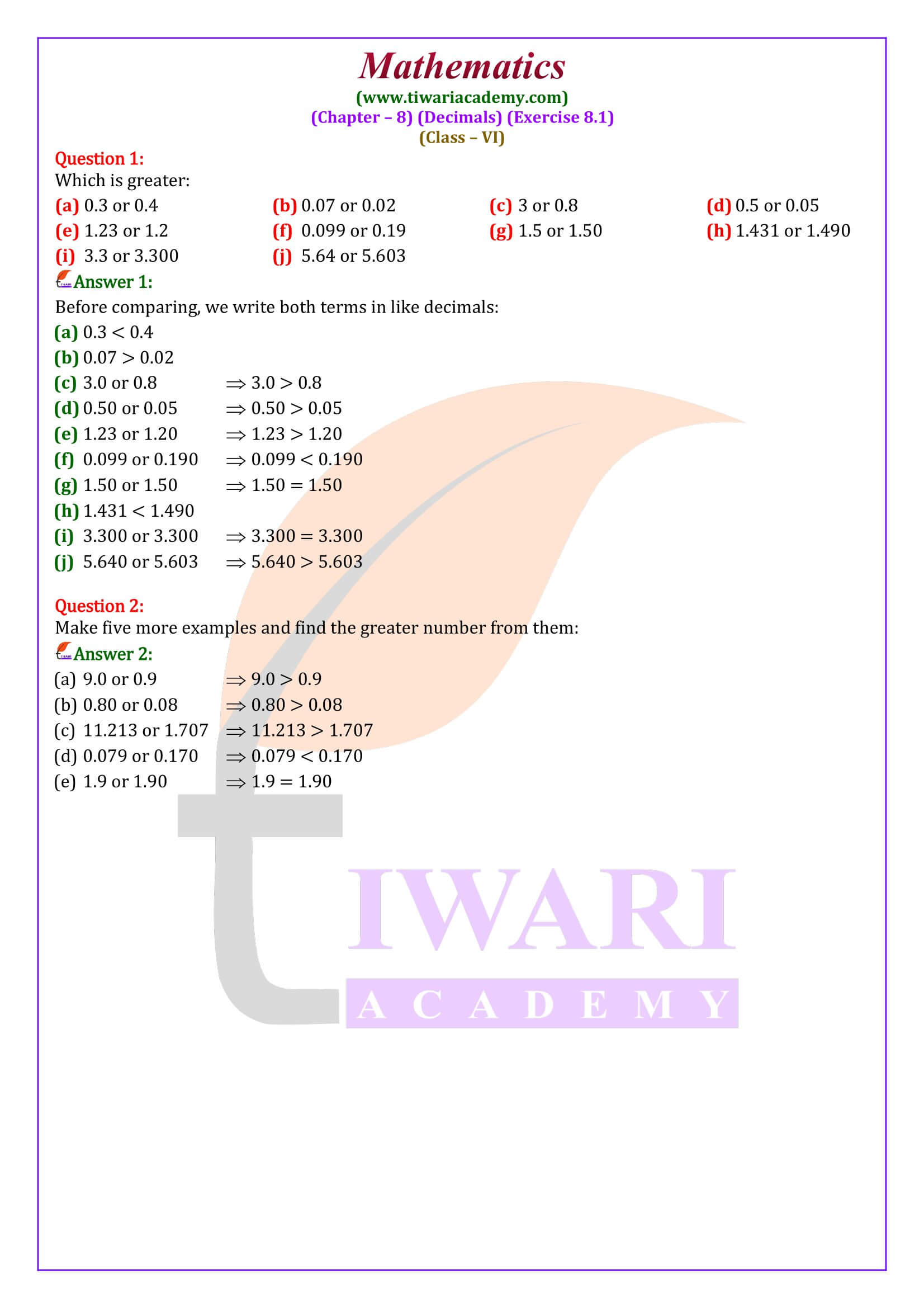NCERT Solutions for Class 6 Maths Chapter 8 Exercise 8.1 in English and Hindi Medium updated for CBSE session 2025-26. The question answers explanation of ex. 8.1 of 6th math are revised on the basis of new NCERT books published for academic year 2025-26.
6th Maths Exercise 8.1 Solutions in Hindi and English Medium
| Class: 6 | Mathematics |
| Chapter: 8 | Exercise: 8.1 |
| Topic Name: | Decimals |
| Content: | NCERT Exercise Solution |
| Session: | CBSE 2025-26 |
| Medium: | Hindi and English |
Class 6 Maths Chapter 8 Exercise 8.1 Solution
Class VI Mathematics book Ex. 8.1 of chapter 8 Decimals solution for new session updated for CBSE and State board exams. All the 6th NCERT (https://ncert.nic.in/) Solutions are in Hindi Medium and English Medium free to use online or download in PDF file format. If you are facing any problem to access the contents, please contact us for help. Videos related to exercise 8.1 of 8th class Maths is also given to help the students.
Like and Unlike Decimals
Like Decimals:
Decimals having the same number of decimal places are called like decimals.
For example, 2.1, 4.6, 8.5 etc. and 2.01, 4.06, 8.05 etc. are groups of like decimals.
Unlike Decimals:
Decimals having different number of decimal places are called unlike decimals. For example, 3.6, 5.58, 6.879 etc. are unlike decimals.
Note: The addition of zeroes to the extreme right of a decimal part does not change the value of the decimal number, i.e., 6.3 = 6.30 = 6.300 = 6.3000 etc. Such decimals are called equivalent but unlike decimals. Thus, without changing the value of a decimal number, the number of decimal places can be increased simply by adding required number of zeroes to extreme right of its decimal part.
Conversion of Unlike Decimals into Like Decimals
Example 1:
Express 4.3, 0.752, 52.56, 183.06 as a set of like decimals.
Here, the decimal number having highest decimal places is 0.752. It has 3 decimal places. Therefore, we have to convert other decimals into their equivalent decimals which have three decimal places, i.e., 4.3 = 4.300, 52.56 = 52.560 and 183.06 = 183.060 Thus, 4.300, 0.752, 52.560 and 183.060 is a set of like decimals.
Class 6 Maths Exercise 8.1 Important Questions
Compare 18.69 and 11.32.
Given decimals are 18.69 and 11.32.
Let us compare their whole number parts.
Clearly, 18 > 11.
So, 18.69 > 11.32
Which is greater 24.875 or 24.814?
Given decimals are 24.875 and 24.814.
Here, both the decimals have equal whole number parts, namely 24.
So, we compare their decimal parts.
Their tenths digits are same.
Let us compare their hundredths digits.
Clearly, 7 hundredths > 1 hundredth.
So, 24.875 > 24.814.
How many numbers are there after the decimal point?
Decimal numbers, such as O. 6495, have four digits after the decimal point. Each digit is a different place value. The first digit after the decimal point is called the tenths place value.
Does 0 count as a decimal place?
The decimal place accuracy of a number is the number of digits to the right of the decimal point. The decimal point is a period written between the digits of a number. If there is no decimal point, it is understood to be after the last digit on the right and there is no place (zero place) accuracy.
How many decimal places should I round to?
The better rule is to report rounded up to one significant digit, which works across the spectrum of values. Thus a decimal places rule that ignores significant digits does not work.
Comparing Decimals
To compare two decimals, we take these steps:
- Convert the given decimals into like decimals.
- First, compare the whole number parts.
- If they are the same, compare the tenths digits.
- If they are the same, compare the hundredths digits and so on.
What will students learn in exercise 8.1 of 6th standard Maths NCERT?
In exercise 8.1 of 6th standard Maths students will learn how to compare decimals. Example of comparison:
Let us now compare the numbers 32.55 and 32.5.
In this, we first compare the whole part. We see that the whole part for both the numbers is 32 and, hence, equal. We, however, know that the two numbers are not equal. So, we now compare the tenth part. We find that for 32.55 and 32.5, the tenth part is also equal, and then we compare the hundredth part.
We find,
32.55 = 32 + 5/10 + 5/100 and 32.5 = 32 + 5/10 + 0/100, therefore, 32.55>32.5 as the hundredth part of 32.55 is more.
Is exercise 8.1 of 6th standard Maths important for the exams?
Yes, exercise 8.1 of 6th standard Maths is important for the exams. Questions from this exercise can come in the exams. This exercise has only two questions and one example. All the problems of this exercise are important for the exams. Students should practice all problems to get good marks in exams.
How much time is required to complete exercise 8.1 of 6th standard NCERT Maths?
Exercise 8.1 of 6th standard Maths is very short. This exercise has only three sums (two questions and one example). Students require a maximum of 2-3 hours to complete exercise 8.1 of 6th standard Maths. This time can vary because of many factors like student’s efficiency, ability, etc.
Is exercise 8.1 of 6th standard Maths easy to solve and understand?
Yes, exercise 8.1 of 6th standard Maths is the easiest. This exercise is very easy to solve and understand. Once students learn how to solve this exercise then they enjoy doing this exercise. The concept of this exercise is also very easy to understand.




